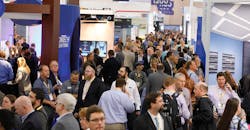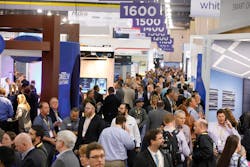Lightfair International 2017, held in Philadelphia from May 9-11, featured more than 550 exhibitors, offering a wide range of architectural, commercial, industrial, and residential lighting products. Promising innovations in sensors and controls lined the aisles of the exhibit halls, but solid-state lighting (SSL) equipment continued to dominate, since LEDs can be controlled down to the individual diode, allowing for dynamic alteration of color, hue, and saturation.
Luminaire design is evolving dramatically with the integration of technologies that can help reduce energy and operating cost, improve the comfort and utilization of a space, as well as offer personalized light and deliver value that goes beyond illumination. These benefits are achieved by using various sensors and a networked lighting control system to provide, for example, asset tracking, space utilization and indoor positioning, diagnosing and reporting, conference room scheduling, security, energy tracking, and integration with building management/HVAC systems.
Product development news straight from the show floor
Many manufacturers at the show demonstrated their dynamic/tunable white lighting products. Variable Correlated Color Temperature (CCT) and daylight responsive lighting now can be handled with a 4.5mm × 4.7mm chip, installed as part of a control system in a luminaire. Thus, the visible light spectrum can be fully controlled, mimicking natural light and providing tangible benefits. The change in color temperature of the light source can assist human performance by helping to set our biological clock, while, at the same time, providing non-visual clues that our brains act on.
Hubbell Lighting displayed SpectraSync, available with a portfolio of commercial and architectural luminaires, which enables four strategies using 0-10V or DMX and Lutron control protocols:
- Dim to Warm, which mimics the warming effect of incandescent sources as they are dimmed;
- Scheduled White, which enables a user to set up both light intensity and CCT across the day to simulate sunlight from sunrise to sunset, or an alternate user-defined sequence;
- Tunable White, which offers a personal preference on intensity and CCT; and
- Dynamic Spectrum, which enables independent control of light intensity, correlated color temperature, hue, and saturation.
Acuity Brands Lighting featured its Mainstream Dynamic tunable technology for five different scenarios: Warm Dim, Tunable White, Architainment Color, Grayscale, and Color Accent. The company also introduced LightFlex LED from Sunoptics, an integrated tunable-white LED tubular daylighting system for commercial environments, which combines both natural and tunable LED lighting.
Philips Lighting showed off four ceiling luminaires that have four presets that can enhance classroom activities. The Standard setting covers common activities; the Presentation setting features a warmer CCT: the Focus setting uses cooler CCT and high intensity to provide optimum conditions for exams, and the Calm mode features dimmed and warm-CCT light for relaxed activities.
Since daylighting is now part of evolving energy codes requiring coordination of passive sources with electrical lighting, Legrand’s Solarfective shading and skylighting systems can be fully integrated with the Wattstopper architectural dimming platform. Legrand also announced its latest offerings with its Wattstopper Digital Lighting Management (DLM) system, which now offers tunable color and wireless capabilities. The company introduced a DLM Color Control Preset Switch that offers four buttons to store color temperature settings. Also introduced was the Wattstopper Architectural Dimming Panel with Main Lug option, featuring a high-density, fully configurable control for all light sources and BACnet network capabilities.
In recognizing the potential for both tunable white devices and shading systems, Lutron Electronics Co., Inc., has simplified and integrated its lighting control and energy management programs, enabling them to respond to a keypad, a remote device or a web-based graphic floor plan on a smart device. The shading systems provide a key component for high-performance buildings, as they help to manage both the thermal load and daylight entry at windows. In addition, the company’s Integral Fixture Control platform, the EcoSystem, operates a variety of tunable white luminaires through alliances with companies like Lumenetix. The operation is also compatible with Phillips Xitanium SR drives, eliminating the need for auxiliary components.
After acquiring four lighting companies over the past few years, Leviton Manufacturing Co. has set up a Lighting Business Unit. The firm’s DeoraSmart family of products offers remote access, app-based scheduling, and voice control for residential applications. The Samsung Electronics SmartThing Automation Bundle by Leviton simplifies the installation of switches, sensors, and other devices served by a number of wireless protocols.
Current, powered by GE, sees LED lighting as poised to become part of a larger network that can soak up data and provide analytics that deliver additional productivity and efficiency. Its expanded line of indoor and outdoor commercial and industrial LED luminaires can be networked wirelessly (using Daintree Networks equipment) and be integrated with the company’s industrial IoT platform, Predix.
Eaton showcased a set of connected lighting solutions for buildings, communities and homes, The WaveLinx wireless system works through mobile apps and is suited for small- and medium-sized offices and educational environments; the
LumaWatt Pro connected system, powered by Enlightened, delivers an advanced IoT solution for indoor and outdoor lighting systems. The ConnectedWorks system powered by CIMCON provides cities, utilities, and universities with integrated systems for outdoor street roadway and utility lighting applications.
Cree, Inc., has expanded its OSQ Series of area and flood LED luminaires with the addition of products rated from 341W to 550W, that deliver up to 65,000 lumens. The company also introduced its SmartCast Intelligence Platform, a combination of hardware (Power over Ethernet), innovative analytics software and services. The SmartCast Advisor monitors the energy performance of a building and provides insights for improvements. The ZR-C commercial troffer offers up to 125 lm/W efficiency and SmartCast capability.
Sylvania is focusing its product lineup on helping electrical contractors in their everyday projects. The Contractor Series of LED lamps offers up to an 11,000-hr life, with products spanning A-19, MR15. PAR, BR lamps and RT5/6 LED recessed downlight kits for ceiling cans. A number of indoor, outdoor, and high-bay luminaires and commercial control systems complete the offerings.
A renewed focus on TLEDs
TLEDs, the LED replacement product for linear fluorescent lamps, with their steadily improving performance, wide range of color temperatures, and 50,000 hour lifespans were widely seen on the exhibit floor. However, at present, no standard wattages or lumen packages for this product category exist. Generally, linear fluorescent lamps offer about 95 lm/W, while TLEDs offer 115 lm/W, increasing at about 8 lm/W to 10 lm/W per year, in the short term.
When used as a replacement in a recessed luminaire, TLEDs with their directional emission typically improve the performance, or efficiency, of the fixture in terms of lumens delivered directly downward, although the distribution or appearance of the light output from the troffer is greatly altered. Additionally, the variations in construction of the products are not well understood. For that reason, UL has four classifications for TLEDs:
- Replacement Lamps (UL type A) operate through an existing fluorescent ballast and don’t require mechanical or electrical changes to the existing luminaire.
- Internal Driver/Line Voltage, Lamp-Style Retrofit Kits (UL Type B) in which the ballast of the existing luminaire is bypassed and line voltage is delivered to the lamp holders or sockets.
- Dual-Mode Internal Driver (UL Type A and Type B) operate from the existing ballast but also have the ability to operate on line voltage if the troffer is rewired to bypass the ballast.
- External Driver Lamp-Style Retrofit Kits (UL Type C) use lamps holders to connect to the luminaire, which require rewiring to connect an external driver to serve the TLEDs.
About the Author
Joseph R. Knisley
Lighting Consultant
Joe earned a BA degree from Queens College and trained as an electronics technician in the U.S. Navy. He is a member of the IEEE Communications Society, Building Industry Consulting Service International (BICSI), and IESNA. Joe worked on the editorial staff of Electrical Wholesaling magazine before joining EC&M in 1969. He received the Jesse H. Neal Award for Editorial Excellence in 1966 and 1968. He currently serves as the group's resident expert on the topics of voice/video/data communications technology and lighting.

